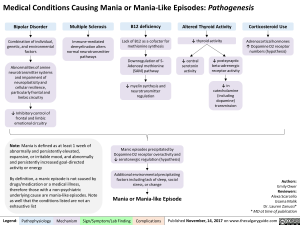Medical Conditions Causing Mania or Mania-Like Episodes: Pathogenesis
Bipolar Disorder Combination of individual, genetic, and environmental factors
Abnormalities of amine neurotransmitter systems and impairment of neuroplasticity and cellular resilience, particularly frontal and limbic circuitry
4, Inhibitory control of frontal and limbic emotional circuitry
Multiple Sclerosis Immune-mediated demyelination alters normal neurotransmitter pathways
B12 deficiency Lack of B12 as a cofactor for methionine synthesis
Downregulation of S-Adenosyl methionine (SAM) pathway
4, myelin synthesis and neurotransmitter regulation
Altered Thyroid Activity Corticosteroid Use 7),
4, thyroid activity
4, central serotonin activity
4, postsynaptic beta-adrenergic receptor activity 4, in catecholamine (including dopamine) transmission
Adrenocortical hormones t Dopamine D2 receptor numbers (hypothesis)
Note: Mania is defined as at least 1 week of abnormally and persistently elevated, expansive, or irritable mood, and abnormally and persistently increased goal-directed activity or energy
By definition, a manic episode is not caused by drugs/medication or a medical illness, therefore those with a non-psychiatric underlying cause are mania-like episodes. Note as well that the conditions listed are not an exhaustive list
Legend:
Pathophysiology Mechanism
Manic episodes precipitated by Dopamine D2 receptor overactivity and 4, serotonergic regulation (hypothesis)
Additional environmental precipitating factors including lack of sleep, social stress, or change Mania or Mania-like Episode
Sign/Symptom/Lab Finding
Complications
Authors: Emily Ower Reviewers: Alexa Scarcello Usama Malik Dr. Lauren Zanussi* * MD at time of publication
Foundations
Systems
Other Languages
Psychiatry Mood Disorders Medical Conditions Causing Mania or Mania-Like Episodes: Pathogenesis Medical Conditions Causing Mania or Mania-Like Episodes: Pathogenesis

